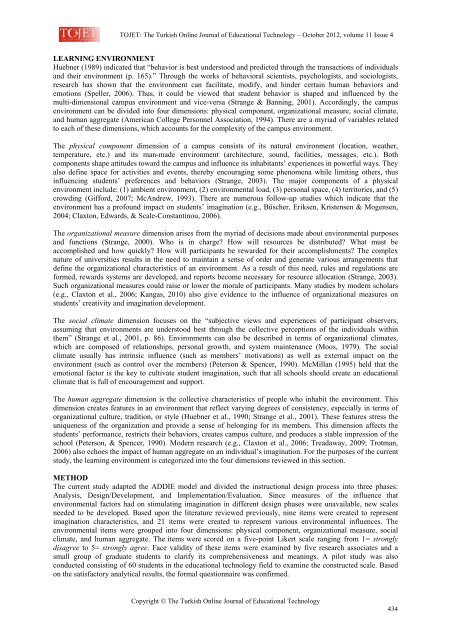october 2012 - TOJET the Turkish online journal of educational ...
october 2012 - TOJET the Turkish online journal of educational ...
october 2012 - TOJET the Turkish online journal of educational ...
You also want an ePaper? Increase the reach of your titles
YUMPU automatically turns print PDFs into web optimized ePapers that Google loves.
<strong>TOJET</strong>: The <strong>Turkish</strong> Online Journal <strong>of</strong> Educational Technology – October <strong>2012</strong>, volume 11 Issue 4<br />
LEARNING ENVIRONMENT<br />
Huebner (1989) indicated that “behavior is best understood and predicted through <strong>the</strong> transactions <strong>of</strong> individuals<br />
and <strong>the</strong>ir environment (p. 165).” Through <strong>the</strong> works <strong>of</strong> behavioral scientists, psychologists, and sociologists,<br />
research has shown that <strong>the</strong> environment can facilitate, modify, and hinder certain human behaviors and<br />
emotions (Speller, 2006). Thus, it could be viewed that student behavior is shaped and influenced by <strong>the</strong><br />
multi-dimensional campus environment and vice-versa (Strange & Banning, 2001). Accordingly, <strong>the</strong> campus<br />
environment can be divided into four dimensions: physical component, organizational measure, social climate,<br />
and human aggregate (American College Personnel Association, 1994). There are a myriad <strong>of</strong> variables related<br />
to each <strong>of</strong> <strong>the</strong>se dimensions, which accounts for <strong>the</strong> complexity <strong>of</strong> <strong>the</strong> campus environment.<br />
The physical component dimension <strong>of</strong> a campus consists <strong>of</strong> its natural environment (location, wea<strong>the</strong>r,<br />
temperature, etc.) and its man-made environment (architecture, sound, facilities, messages, etc.). Both<br />
components shape attitudes toward <strong>the</strong> campus and influence its inhabitants’ experiences in powerful ways. They<br />
also define space for activities and events, <strong>the</strong>reby encouraging some phenomena while limiting o<strong>the</strong>rs, thus<br />
influencing students’ preferences and behaviors (Strange, 2003). The major components <strong>of</strong> a physical<br />
environment include: (1) ambient environment, (2) environmental load, (3) personal space, (4) territories, and (5)<br />
crowding (Gifford, 2007; McAndrew, 1993). There are numerous follow-up studies which indicate that <strong>the</strong><br />
environment has a pr<strong>of</strong>ound impact on students’ imagination (e.g., Büscher, Eriksen, Kristensen & Mogensen,<br />
2004; Claxton, Edwards, & Scale-Constantinou, 2006).<br />
The organizational measure dimension arises from <strong>the</strong> myriad <strong>of</strong> decisions made about environmental purposes<br />
and functions (Strange, 2000). Who is in charge? How will resources be distributed? What must be<br />
accomplished and how quickly? How will participants be rewarded for <strong>the</strong>ir accomplishments? The complex<br />
nature <strong>of</strong> universities results in <strong>the</strong> need to maintain a sense <strong>of</strong> order and generate various arrangements that<br />
define <strong>the</strong> organizational characteristics <strong>of</strong> an environment. As a result <strong>of</strong> this need, rules and regulations are<br />
formed, rewards systems are developed, and reports become necessary for resource allocation (Strange, 2003).<br />
Such organizational measures could raise or lower <strong>the</strong> morale <strong>of</strong> participants. Many studies by modern scholars<br />
(e.g., Claxton et al., 2006; Kangas, 2010) also give evidence to <strong>the</strong> influence <strong>of</strong> organizational measures on<br />
students’ creativity and imagination development.<br />
The social climate dimension focuses on <strong>the</strong> “subjective views and experiences <strong>of</strong> participant observers,<br />
assuming that environments are understood best through <strong>the</strong> collective perceptions <strong>of</strong> <strong>the</strong> individuals within<br />
<strong>the</strong>m” (Strange et al., 2001, p. 86). Environments can also be described in terms <strong>of</strong> organizational climates,<br />
which are composed <strong>of</strong> relationships, personal growth, and system maintenance (Moos, 1979). The social<br />
climate usually has intrinsic influence (such as members’ motivations) as well as external impact on <strong>the</strong><br />
environment (such as control over <strong>the</strong> members) (Peterson & Spencer, 1990). McMillan (1995) held that <strong>the</strong><br />
emotional factor is <strong>the</strong> key to cultivate student imagination, such that all schools should create an <strong>educational</strong><br />
climate that is full <strong>of</strong> encouragement and support.<br />
The human aggregate dimension is <strong>the</strong> collective characteristics <strong>of</strong> people who inhabit <strong>the</strong> environment. This<br />
dimension creates features in an environment that reflect varying degrees <strong>of</strong> consistency, especially in terms <strong>of</strong><br />
organizational culture, tradition, or style (Huebner et al., 1990; Strange et al., 2001). These features stress <strong>the</strong><br />
uniqueness <strong>of</strong> <strong>the</strong> organization and provide a sense <strong>of</strong> belonging for its members. This dimension affects <strong>the</strong><br />
students’ performance, restricts <strong>the</strong>ir behaviors, creates campus culture, and produces a stable impression <strong>of</strong> <strong>the</strong><br />
school (Peterson, & Spencer, 1990). Modern research (e.g., Claxton et al., 2006; Treadaway, 2009; Trotman,<br />
2006) also echoes <strong>the</strong> impact <strong>of</strong> human aggregate on an individual’s imagination. For <strong>the</strong> purposes <strong>of</strong> <strong>the</strong> current<br />
study, <strong>the</strong> learning environment is categorized into <strong>the</strong> four dimensions reviewed in this section.<br />
METHOD<br />
The current study adapted <strong>the</strong> ADDIE model and divided <strong>the</strong> instructional design process into three phases:<br />
Analysis, Design/Development, and Implementation/Evaluation. Since measures <strong>of</strong> <strong>the</strong> influence that<br />
environmental factors had on stimulating imagination in different design phases were unavailable, new scales<br />
needed to be developed. Based upon <strong>the</strong> literature reviewed previously, nine items were created to represent<br />
imagination characteristics, and 21 items were created to represent various environmental influences. The<br />
environmental items were grouped into four dimensions: physical component, organizational measure, social<br />
climate, and human aggregate. The items were scored on a five-point Likert scale ranging from 1= strongly<br />
disagree to 5= strongly agree. Face validity <strong>of</strong> <strong>the</strong>se items were examined by five research associates and a<br />
small group <strong>of</strong> graduate students to clarify its comprehensiveness and meanings. A pilot study was also<br />
conducted consisting <strong>of</strong> 60 students in <strong>the</strong> <strong>educational</strong> technology field to examine <strong>the</strong> constructed scale. Based<br />
on <strong>the</strong> satisfactory analytical results, <strong>the</strong> formal questionnaire was confirmed.<br />
Copyright © The <strong>Turkish</strong> Online Journal <strong>of</strong> Educational Technology<br />
434
















